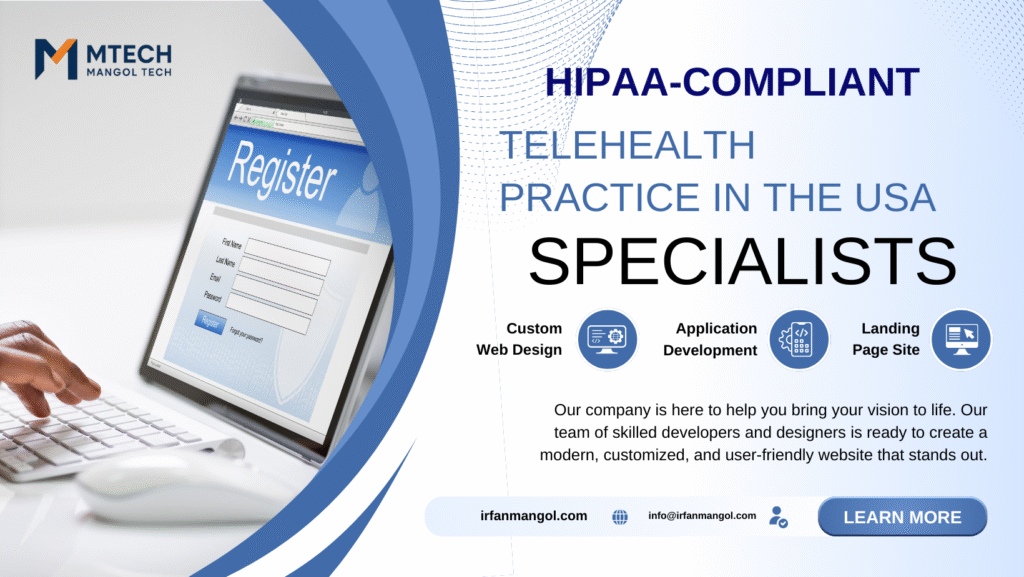Need help with HIPAA compliance? Get a free consultation and start your telehealth practice today.

Table of Contents
- Introduction
- HIPAA and Telehealth: What Matters
- Common Problems (and Fixes)
- Key Components of HIPAA-Compliant Telehealth
- Step-by-Step Setup Guide
- Advanced Techniques
- Client Success Stories
- Quick FAQ
- Implementation Checklist
- Next Steps
1. Introduction
A HIPAA-compliant telehealth practice in the USA protects patient privacy, your license, and your reputation. It’s more than a legal requirement—it’s a trust builder.
Patients want healthcare that is simple, fast, and secure. You need workflows that are encrypted, controlled, and audit-ready. This guide shows you the steps, from safeguards to staff training, so you can launch and scale with confidence.
Why it matters:
- Penalties for non-compliance can be severe—fines from $100 to $50,000 per violation.
- Loss of trust can drive patients away permanently.
- Compliance signals professionalism and care.
2. HIPAA and Telehealth: What Matters
HIPAA protects electronic protected health information (ePHI). In telehealth, that means encryption, access control, audit logs, and vendor agreements. Your video platform, EHR, messaging, and storage must all meet HIPAA’s Security Rule and Privacy Rule.
Official resources:
3. Common Problems (and Fixes)
1) Using non-compliant tools
- Problem: General video apps without a BAA or encryption.
- Fix: Use healthcare plans with BAA, encryption, and admin controls.
2) Weak authentication
- Problem: Shared logins, simple passwords.
- Fix: Unique accounts, MFA, role-based access.
3) Poor data storage and backups
- Problem: ePHI on local devices or insecure clouds.
- Fix: HIPAA-eligible cloud, AES-256 encryption, offsite backups.
4) No staff training
- Problem: Breaches caused by simple mistakes.
- Fix: Quarterly HIPAA training, phishing drills, breach plans.
5) Missing documentation
- Problem: No policies, BAAs, or access logs.
- Fix: Sign BAAs, write policies, log all access and changes.
(Internal Link: Clinic & Telehealth Technology)
More Recommendations
(Once you have these posts live, link them inside this article for SEO)
/clinic-telehealth-technology– Clinic & Telehealth Technology/infermedica-api-patient-screening-hub– How Infermedica API Can Turn Your Clinic Website into a Patient Screening Hub/hipaa-audit-checklist– HIPAA Audit Checklist for Clinics/top-hipaa-cloud-storage– Best HIPAA-Compliant Cloud Storage for Clinics/top-telehealth-platforms– Top Telehealth Platforms for HIPAA Compliance
4. Key Components of HIPAA-Compliant Telehealth
Security Rule compliance
Meet administrative, physical, and technical safeguards for ePHI.
Secure communication (encryption)
Encrypt video, chat, and file transfers in transit and at rest.
User authentication
Verify identities before granting access to ePHI.
Access control
Limit access strictly to roles that require it.
Risk assessment
Identify risks, apply safeguards, reassess after changes.
Data storage and disposal
Secure storage, retention policies, and documented secure deletion.
Business Associate Agreements (BAAs)
Sign BAAs with all vendors handling ePHI.
Administrative safeguards
Policies, workforce training, sanctions, incident response plans.
Physical safeguards
Secure physical locations, controlled device access.
Technical safeguards
Encryption, role-based access, unique IDs, audit logs.
5. Step-by-Step Setup Guide
Step 1 – Choose compliant platforms
- Telehealth video platform with BAA
- HIPAA-eligible cloud storage
- Encrypted ePrescribe/eFax tools
- Patient portal with encryption and access logs
Step 2 – Lock down identity and access
- MFA for all staff and admins
- Role mapping (admin, clinician, billing, support)
- Disable unused accounts quickly
Step 3 – Encrypt everywhere
- TLS 1.2+ in transit
- AES-256 at rest
- Mobile device encryption, remote wipe enabled
Step 4 – Build safe workflows
- Booking → Consent → Secure Video → Encrypted Notes → Billing
- Avoid sending ePHI over email; use secure portals.
Step 5 – Train your team
- Quarterly HIPAA training
- Phishing simulations
- Clear role-specific guidelines
Step 6 – Documentation and BAAs
- Signed BAAs tracked
- Policies version-controlled
- Risk management plan updated
Step 7 – Test, audit, improve
- Quarterly audits
- Timely security patches
- Incident response drills twice a year
6. Advanced Techniques
- Zero trust model – Verify every device and connection.
- Data Loss Prevention (DLP) – Stop accidental sharing.
- Continuous monitoring – Alert on failed MFA, suspicious downloads.
- HL7 FHIR compliance – Use standard APIs for interoperability.
- Patient trust signals – Clear privacy notices in patient portals.
7. Client Success Stories
“We passed our HIPAA audit with zero findings. The workflow reduced no-shows by 22%.” — Family Care Group, Ohio
“MFA and clear policies cut incidents almost overnight.” — Midtown Pediatrics, Texas
“Patients say they feel safer and mention privacy in reviews.” — Harbor Telehealth, Florida
9. Implementation Checklist
People:
- HIPAA officer assigned
- Quarterly training scheduled
- Onboarding/offboarding documented
Process:
- Policies approved and updated
- Incident response plan tested
- Risk analysis documented
Platform:
- Vendors have signed BAAs
- MFA and least privilege in place
- Encryption verified
- Backups tested and secure
10. Next Steps
Need help with HIPAA compliance? Get a free consultation and start your telehealth practice today.
Contact Us | See Our Services

Irfan Mangol is a professional web designer and Local SEO strategist specializing in Clinic & Telehealth Website Design for dermatology and cosmetic clinics across the USA.Inspired by insights from Moz, BrightLocal, and Search Engine Journal, he helps medical professionals boost patient engagement and rank higher ethically through strategic web design and SEO solutions.Learn more at irfanmangol.com.
Is a BAA required with my video vendor?
Yes, if they handle ePHI. Always have a signed BAA.
Can I email patient records?
Prefer portals. If email is necessary, use encryption and patient consent.
How often should I do a risk assessment?
Annually at minimum, plus after major changes.
Where do I find official rules?
HHS Security and Privacy Rule summaries are the best starting points.
What is remote monitoring in telehealth?
Remote patient monitoring lets clinicians access at-home and mobile devices, including wearables, to monitor and manage their patients’ chronic and acute medical conditions, such as heart disease, diabetes, cancer, asthma, irregular sleep patterns, and even difficult pregnancies.
What is the main key to HIPAA compliance?
Maintaining detailed records and documentation is a key aspect of HIPAA compliance. Organizations must document all policies, procedures, and actions taken to protect PHI. This includes records of self-audits, training sessions, and breach notifications.